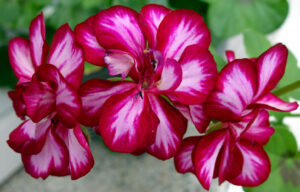
What makes a geranium?
By Clive Larkman
There are multiple genera of plants that have real naming issues that confuse the general public and irritate those working in industry or academia. A big one is the misnomers with Geranium and Pelargonium. Both of these are legitimate Latin genus names and both are used as common names. The problem is that many Pelargonium species are referred to as geraniums.
There is also a third genus called Erodium. All three are in the family Geraniaceae and originally all three were in the one genus Geranium. As this goes back to the days of Linnaeus there was always a good chance the genus would be reviewed and split. This happened late in the 18th century and based on the flower parts, the genus Geranium was split into Pelargonium,Erodiumand Geranium.
All the species have five petals and basically Pelargonium and Erodium have different petals between the top and bottom petals. Members of the genus Geranium have five identical petals. However, with double and semi-double flowers (mostly Pelargonium) it is hard to tell if they are the same or not. There are now some Pelargoniumcultivars which have five symmetrical petals. With simple flowered forms there is a consistent difference between the three in that Geranium flowers have ten stamens, Erodium flowers have five stamens andPelargonium flowers have seven stamens.
All three have several common names but there is consistency in that the name comes from the shape of the fruit. It resembles the bill of one of three birds which is also the origin of the Latin name. Erodium is said to resemble the bill of the common heron which has the Ancient Greek name Erodius. Pelargonium comes from the Ancient Greek name for storks (Pelargos) due to the fruit resembling the stork’s bill. Finally, Geranium comes from the Ancient Greek name for the crane, Geranos due to its fruit looking like a crane’s bill. The fruit shape also gives rise to the common names, Crane’s Bill, Heron’s Bill and Stork’s Bill. These names are mixed up between countries and growers, another reason why we don’t use common names.

However, the botanist Charles L’Heritiere de Brutelle decided to split the genus and it seems to have worked well. In botany, one of the base classifications is that of species and supposedly different species cannot naturally cross and provide viable offspring. Over time this has been softened as we find more, and produce more, interspecific hybrids. Then there is the issue of crosses of plants in different genera. These are called inter-generic hybrids and are very rare. They are usually given a name that is a blend of the two genera and technically start with the letter X, e.g., ‘Castlewellan Gold’ is a cross between Cupressus macrocarpa x Chamaecyparis nootkatensis and has the name XCupressocyparis leylandii. For ease of use, the initial X is usually dropped. I am unable to find any case of an intergeneric cross between any plants of the three genera and I am sure many have tried to cross them.
Most perennial growers can pick which genus a plant belongs to. Basically Erodiums are small rockery-like plants with white to deep pink flowers. There are over 50 species and they originate in northern America, southern and western Asia, the Middle East and Australia. Plants in the genus Geranium are referred to as Hardy Geraniums based on the fact that they are more cold tolerant than those in the genus Pelargonium and are widely grown in the northern hemisphere. Many are herbaceous and will die back in a cold winter and re-shoot in spring.
Geranium is a large genus with over 400 species that are found in most temperate regions of the world. Most will tolerate quite cold environments and are quite easy to grow. The flowers range from white to purple with some forms that are almost blue, one of which, ‘Rozannne’, was voted the RHS plant of the century. The majority of them have palmate or lobed leaves although some have heavily dissected leaves. There are quite a few species and cultivars with deep grey foliage that make excellent border plants. Most of these have dainty white flowers.
The third genus, Pelargonium has almost 300 species from the warmer temperate regions of the world, with the vast majority coming from southern Africa. There are several species from Australia, New Zealand and the islands of the southern Atlantic and Indian oceans. The genus is divided into several groups for common name usage. The most popular ornamental group is the Zonal Geraniums which are the larger growing colourful flowering forms most gardeners call ‘geraniums’ and are very popular in old perennial gardens and in window boxes and street plantings. Closely related, and also known as geraniums, are the Regal Pelargoniums, which also have large showy flowers popular in perennial gardens.
The final group is what we call the Scented Pelargoniums which is made up of a few species, but hundreds of cultivars. These all have medium to large leaves with very strong aromas that are popular in making teas and used in aromatherapy. The fragrances vary greatly, from rose scented (Pelargonium graveolens) to peppermint scented (Pelargonium tomentosum) and lemon scented (Pelargonium crispum) with everything in between, including cinnamon, nutmeg and apple cider. One has a rare fragrance in plants that is reminiscent of coconut. This is Pelargonium grossularioides and along with Pelargonium x fragrans is similar in appearance to some of the small grey leaved Geraniums. Many of these plants are very drought hardy and will grow in very dry light shade, e.g., under pine trees.
Hopefully, this details the level of variation in three genera of plants that are popular in gardens around the world. I doubt the gardening community will ever stop calling them all Geraniums but we just need to know what plant they are talking about.
Main image: Geraniums are perfect for planter boxes and garden beds (Image: Pixabay Marisa04)
